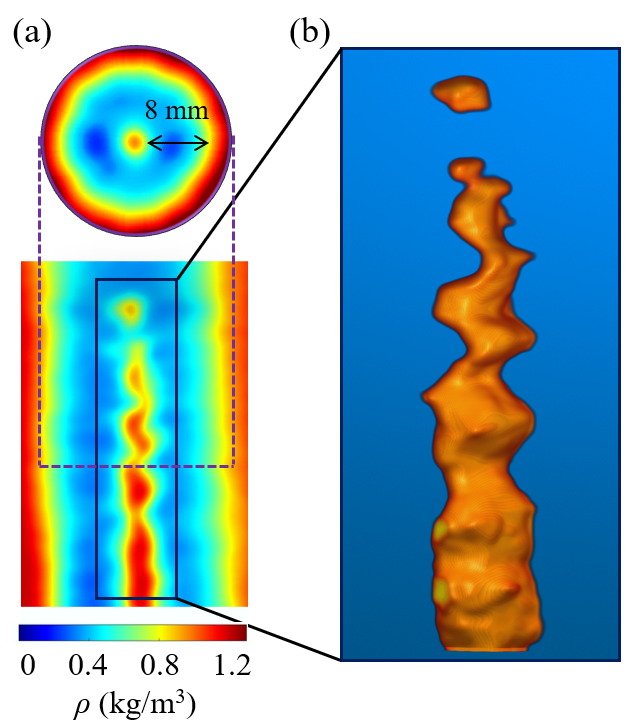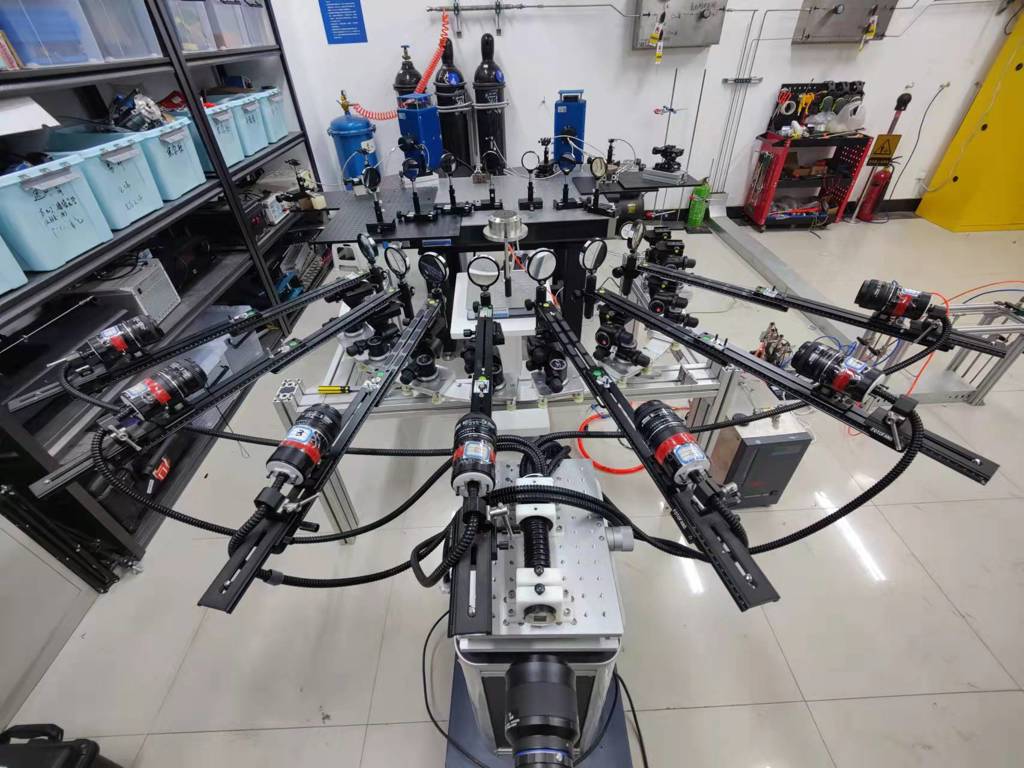New high-speed imaging method captures 3D details of combustion flames
About Optica
26 July 2023
New high-speed imaging method captures 3D details of combustion flames
A better understanding of flame behavior could enable more efficient and cleaner cars, airplanes, factories and power plants

Caption: A new high-speed 3D imaging method can capture the complex behavior of the turbulent flames produced during combustion. Shown are two cross sections of the 3D density measurement at Z = 16 mm and X= 0 mm, respectively(a) and the 3D iso-surface of the largest density gradient between the mixture and burned product (b).
Credit: Qingchun Lei, Northwestern Polytechnic University
WASHINGTON — Researchers have developed a new method for capturing the complex behavior of turbulent flames produced during combustion. Insights provided by this high-speed 3D imaging approach could be used to develop more efficient and cleaner combustion systems for cars, airplanes, factories and power plants.
“The high-speed imaging approach we developed provides detailed insights into flame dynamics, ignition processes and combustion behavior,” said Qingchun Lei from Northwestern Polytechnic University in China. “This can provide insights into combustion efficiency, pollutant emissions and the optimization of energy production processes that could be used to improve the design and operation of power plants, engines, and other combustion devices, leading to reduced environmental impact and enhanced energy efficiency.”
In the Optica Publishing Group journal Optics Letters, the researchers describe their new technique which adds high-speed image reconstruction and 3D information to schlieren imaging, a well-established technique for imaging and measuring phenomena in fluids. The new method can be used to quantitatively obtain the 3D density and velocity distribution of turbulent flames.
“The detailed understanding of flame behavior and ignition processes facilitated by this technique can also contribute to more effective fire safety measures by providing information on how fires spread, develop and can be suppressed,” said Lei. “This can be used to enhance fire prevention strategies, improve building designs and develop more efficient fire suppression systems that could ultimately help save lives, protect property and improve overall fire safety standards.”
Adding speed and multiple perspectives
Because turbulent combustion is highly dynamic and 3D in nature, it is difficult to quantitatively capture it sufficiently using measurement methods such as traditional schlieren imaging. To solve this problem, the researchers combined three imaging methods: fiber imaging, schlieren imaging and computed tomography (CT).
The new technique uses a series of fiber bundles to transmit light containing flame information from different angles. Each angle of light rays forms a Toepler's lens-type schlieren system that can image the density variations of the target flames. CT, which is commonly used in medical imaging, is then employed to reconstruct the 3D schlieren images. Finally, post-processing of the 3D schlieren images is used to obtain 3D density and velocity information.
“Fiber imaging enables high-speed, simultaneous schlieren imaging from multiple perspectives in a flexible and cost-effective manner while adding CT enables the 3D reconstruction of target flames based on the multi-angular 2D images,” said Lei. “The resulting high-speed 3D schlieren imaging technique achieves a frame rate beyond tens of kHz, which allows the capture of rapidly changing flame phenomena with exceptional temporal resolution, providing detailed insights into transient flame events.”

Caption: The experimental setup included a single high-speed camera, two Xenon lamps and a series of fiber bundles. This equipment is all relatively affordable compared to more complex and specialized equipment, such as lasers, used in other techniques.
Credit: Qingchun Lei, Northwestern Polytechnic University
Capturing complex flame dynamics
To validate the effectiveness and performance of the high-speed 3D schlieren imaging approach, the researchers conducted experiments on turbulent and laminar premixed flames as well as transient ignition processes. The experimental setup included a single high-speed camera, two Xenon lamps and a series of fiber bundles. The fiber bundles were positioned to capture schlieren images of the flames from seven different orientations simultaneously while the camera recorded the images at a high frame rate. The experimental setup is relatively affordable compared to more complex and specialized equipment, such as lasers, used in other techniques.
The results of the experiments showed that the high-speed 3D schlieren imaging approach successfully captured and measured the flame dynamics, structure and ignition processes.
The researchers are now working to enhance the technique’s practicality and potential for commercialization. This includes testing its robustness and reliability across a broader range of flame conditions and configurations as well as optimizing the image processing and reconstruction algorithms. They also want to improve system integration and automation and further simplify the setup.
Paper: X. Li, Q. Lei, W. Bao, X. Li, W. Fan, “Fiber-based high-speed 3D schlieren imaging,” Opt. Lett., vol. 48, issue 15, pp. 4081-4084 (2023).
DOI: https://doi.org/10.1364/OL.496333
Media Contact
